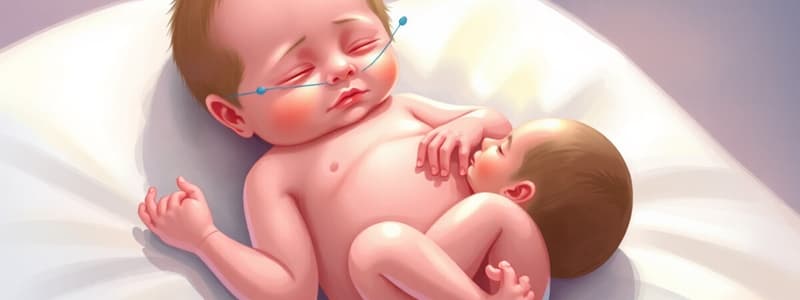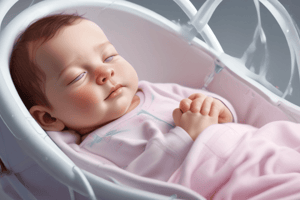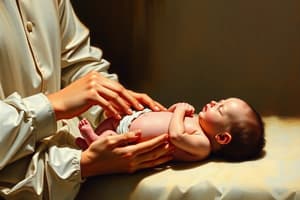Podcast
Questions and Answers
What is the appropriate heart rate for a newborn categorized as having a score of 2?
What is the appropriate heart rate for a newborn categorized as having a score of 2?
- < 100 b.p.m
- Between 80-90 b.p.m
- Absent
- ≥ 100 b.p.m (correct)
Which of the following is a characteristic of a newborn that predisposes them to heat loss?
Which of the following is a characteristic of a newborn that predisposes them to heat loss?
- Blood vessels are deep within the skin
- Thick skin
- Thin skin (correct)
- Relatively small body mass
During what process is the umbilical cord cut and clamped?
During what process is the umbilical cord cut and clamped?
- The cord is cut immediately after birth regardless of pulsations
- Cord clamping is performed to decrease blood volume
- Clamping the cord increases heart rate
- Clamping and cutting the cord separate the infant from the placenta (correct)
What does a respiratory effort score of 1 represent in a newborn?
What does a respiratory effort score of 1 represent in a newborn?
What is the expected blood volume range for a term newborn infant?
What is the expected blood volume range for a term newborn infant?
Why is it important to ligate the cord carefully?
Why is it important to ligate the cord carefully?
What does a muscle tone score of 0 indicate for a newborn?
What does a muscle tone score of 0 indicate for a newborn?
What is the purpose of the healthy full-term infant's flexion position?
What is the purpose of the healthy full-term infant's flexion position?
What is the primary purpose of administering vitamin K to a newborn?
What is the primary purpose of administering vitamin K to a newborn?
Which medication is most commonly used for eye prophylaxis in newborns?
Which medication is most commonly used for eye prophylaxis in newborns?
What is a crucial step to ensure after a vivisection concerning newborns?
What is a crucial step to ensure after a vivisection concerning newborns?
What should breast self-examinations primarily focus on?
What should breast self-examinations primarily focus on?
What does the deficiency of vitamin K in newborns lead to?
What does the deficiency of vitamin K in newborns lead to?
Why are breast self-examinations recommended for women?
Why are breast self-examinations recommended for women?
What is the recommended dosage of vitamin K for a neonate?
What is the recommended dosage of vitamin K for a neonate?
When should vitamin K be administered to newborns?
When should vitamin K be administered to newborns?
What is the primary cause of heat loss through evaporation in neonates?
What is the primary cause of heat loss through evaporation in neonates?
Which of the following practices helps to reduce conduction heat loss in neonates?
Which of the following practices helps to reduce conduction heat loss in neonates?
What environmental condition can help prevent convective heat loss in a newborn?
What environmental condition can help prevent convective heat loss in a newborn?
How can radiant heat loss be minimized for neonates?
How can radiant heat loss be minimized for neonates?
What is one reason infants should be kept away from outside walls in a healthcare setting?
What is one reason infants should be kept away from outside walls in a healthcare setting?
Which method of identification is commonly used for infants in a hospital?
Which method of identification is commonly used for infants in a hospital?
What type of heat loss occurs when a newborn is in direct contact with cold objects?
What type of heat loss occurs when a newborn is in direct contact with cold objects?
Which of the following is NOT a method mentioned to reduce heat loss in neonates?
Which of the following is NOT a method mentioned to reduce heat loss in neonates?
At what age should individuals begin performing breast self-examinations (BSE)?
At what age should individuals begin performing breast self-examinations (BSE)?
What is the recommended approach for performing the BSE after a menstrual cycle?
What is the recommended approach for performing the BSE after a menstrual cycle?
Which pressure technique is NOT suggested for conducting a breast self-exam?
Which pressure technique is NOT suggested for conducting a breast self-exam?
What should individuals be aware of regarding their family history when planning for BSE?
What should individuals be aware of regarding their family history when planning for BSE?
Which of the following findings should prompt further investigation after a BSE?
Which of the following findings should prompt further investigation after a BSE?
What technique is recommended to remember monthly BSE?
What technique is recommended to remember monthly BSE?
When performing the BSE, what pattern is suggested for examining the breast tissue?
When performing the BSE, what pattern is suggested for examining the breast tissue?
What should be done if unusual lumps or changes are detected during a BSE?
What should be done if unusual lumps or changes are detected during a BSE?
What is the primary objective of conducting a breast exam?
What is the primary objective of conducting a breast exam?
Which step should be taken after the breast examination is defined?
Which step should be taken after the breast examination is defined?
What is recommended to keep track of changes during a breast self-exam (BSE)?
What is recommended to keep track of changes during a breast self-exam (BSE)?
Which hand movements are recommended for covering the entire breast during a self-exam?
Which hand movements are recommended for covering the entire breast during a self-exam?
During the breast examination, what should the woman be reminded to do for optimal results?
During the breast examination, what should the woman be reminded to do for optimal results?
What is a key aspect of an annual clinical breast exam alongside a BSE?
What is a key aspect of an annual clinical breast exam alongside a BSE?
What should be assessed during the antenatal period in a breast examination?
What should be assessed during the antenatal period in a breast examination?
Which procedure should be taken immediately before starting the breast examination?
Which procedure should be taken immediately before starting the breast examination?
What is the correct position for examining the right breast initially?
What is the correct position for examining the right breast initially?
During the palpation of the breast, how should the fingers be positioned?
During the palpation of the breast, how should the fingers be positioned?
How should the underarm area be examined?
How should the underarm area be examined?
What should be done after examining the nipples?
What should be done after examining the nipples?
Which step should be performed last during the breast examination process?
Which step should be performed last during the breast examination process?
Flashcards
Newborn Appearance
Newborn Appearance
Describes the color of the newborn's skin, including shades like blue, pale, or pink.
Newborn Pulse
Newborn Pulse
Heart rate of a newborn, measured in beats per minute (bpm).
Newborn Reflexes
Newborn Reflexes
Newborn reflexes such as grimace or withdrawal.
Newborn Muscle Tone
Newborn Muscle Tone
Signup and view all the flashcards
Newborn Respiration
Newborn Respiration
Signup and view all the flashcards
Umbilical Cord Clamping
Umbilical Cord Clamping
Signup and view all the flashcards
Newborn Heat Loss
Newborn Heat Loss
Signup and view all the flashcards
Thermal Adaptation
Thermal Adaptation
Signup and view all the flashcards
Neonate Heat Loss - Evaporation
Neonate Heat Loss - Evaporation
Signup and view all the flashcards
Neonate Heat Loss - Conduction
Neonate Heat Loss - Conduction
Signup and view all the flashcards
Neonate Heat Loss - Convection
Neonate Heat Loss - Convection
Signup and view all the flashcards
Neonate Heat Loss - Radiation
Neonate Heat Loss - Radiation
Signup and view all the flashcards
Preventing Neonate Heat Loss
Preventing Neonate Heat Loss
Signup and view all the flashcards
Warming Oxygen
Warming Oxygen
Signup and view all the flashcards
Delivery Room Temperature
Delivery Room Temperature
Signup and view all the flashcards
Infant Identification
Infant Identification
Signup and view all the flashcards
Infant Care: Eye Prophylaxis
Infant Care: Eye Prophylaxis
Signup and view all the flashcards
Neonatal Vitamin K
Neonatal Vitamin K
Signup and view all the flashcards
Hemorrhagic Disease of the Newborn
Hemorrhagic Disease of the Newborn
Signup and view all the flashcards
Breast Self-Exam (BSE)
Breast Self-Exam (BSE)
Signup and view all the flashcards
BSE Purpose: Topography
BSE Purpose: Topography
Signup and view all the flashcards
BSE Purpose: Early Detection
BSE Purpose: Early Detection
Signup and view all the flashcards
BSE Importance
BSE Importance
Signup and view all the flashcards
BSE Method
BSE Method
Signup and view all the flashcards
Breast Palpation Technique
Breast Palpation Technique
Signup and view all the flashcards
Underarm Examination
Underarm Examination
Signup and view all the flashcards
Nipple Examination
Nipple Examination
Signup and view all the flashcards
Reporting Abnormalities
Reporting Abnormalities
Signup and view all the flashcards
Recording Findings
Recording Findings
Signup and view all the flashcards
BSE Timing
BSE Timing
Signup and view all the flashcards
BSE Pressure Levels
BSE Pressure Levels
Signup and view all the flashcards
BSE Circles
BSE Circles
Signup and view all the flashcards
BSE Lines
BSE Lines
Signup and view all the flashcards
BSE: Visual Inspection
BSE: Visual Inspection
Signup and view all the flashcards
BSE: Touch Exam
BSE: Touch Exam
Signup and view all the flashcards
BSE: Family History
BSE: Family History
Signup and view all the flashcards
Breast Exam Procedure
Breast Exam Procedure
Signup and view all the flashcards
Objective of Breast Exam
Objective of Breast Exam
Signup and view all the flashcards
Breast Exam - Inspection
Breast Exam - Inspection
Signup and view all the flashcards
BSE - Tips
BSE - Tips
Signup and view all the flashcards
Breast Exam - Postpartum
Breast Exam - Postpartum
Signup and view all the flashcards
Breast Exam - Abnormal Findings
Breast Exam - Abnormal Findings
Signup and view all the flashcards
Study Notes
Immediate Care of the Newborn Baby
- Immediate care of new born babies involves clearing the airway, assessing the baby's condition using the Apgar score, clamping and cutting the umbilical cord, ensuring thermal adaptation, identification, caring for the eyes, and administering Vitamin K.
Clearing the Airway
- Immediately after birth, the mouth and nasopharynx (nose) should be suctioned to remove mucus, blood, and meconium.
- Mechanical suction is used to minimise the risk of virus transmission.
Assessment of Baby's Condition Using Apgar Score
- The Apgar score is a scoring system to assess the cardiopulmonary function of a newborn baby.
- This assessment is performed at 1 minute and 5 minutes after birth.
- Scores range from 0 to 10, with 7-10 indicating normal adaptation, 3-6 indicating mild to moderate distress, and 0-2 indicating severe distress, requiring resuscitation and ICU admission.
- Appearance (color), Pulse (heart rate), Grimace (reflexes), Activity (muscle tone), and Respiration are assessed.
Clamping and Cutting the Cord
- The umbilical cord, containing two arteries and one vein (covered by Wharton's jelly),is approximately 50 cm long.
- The cord is clamped and divided approximately 8-10 cm from the umbilicus.
- Clamping should be performed after pulsations cease to prevent excessive blood loss.
- The cord is ligated using a clamp or rubber bands/tapes.
- Blood volume of a full-term new-born is approximately 80-100mL per kg body weight.
Thermal Adaptation
- Newborn babies are prone to heat loss due to thin skin and blood vessels close to the surface.
- Heat loss can occur through evaporation, conduction, convection, and radiation.
- Keeping the baby in apposition (flexed position) to reduce surface area exposed to air, and maintaining warm ambient temperatures minimizes heat loss.
Identification
- Infants are identified with name bands, usually placed on the wrist and ankle.
- Bands should include the family name, sex, date and time of birth (until discharge from hospital).
Care of the Eyes
- Newborn babies should receive prophylactic eye treatment to prevent ophthalmic neonatorum.
- Tetracycline or erythromycin ointment are common medications used for eye prophylaxis
Vitamin K
- Administering Vitamin K prevents hemorrhagic disease by ensuring the production of clotting factors, preventing potential bleeding problems.
- Administration is typically intramuscular, 0.5mg to 1mg of water soluble Vitamin K within the first hour of birth.
Breast Self-Examination (BSE)
- Monthly breast self-exams (BSEs) involve visual and manual inspection for any changes in the contour or texture of the breasts and visual inspection of the breasts with and without a mirror, along with manual inspection in various positions.
- An examination should be performed one week after the onset of the menstrual period to minimise tenderness/swelling.
- This early detection helps in early treatment of breast cancer.
- Following a pattern (up and down), using various pressures, covering the entire breast area, feeling for lumps, unusual changes, symmetry, and texture.
- The procedure should be performed regularly (at least once a month) for early detection of breast abnormalities.
Procedure Checklist: Breast Exam
- The checklist outlines the steps involved in a breast exam, which includes welcoming the patient.
- This procedure includes a comprehensive inspection and palpation of the breasts in various positions.
- Steps also include identifying objectives, placing the patient on the examination couch, draping her, closing the door/curtain, and washing hands after the procedure.
Studying That Suits You
Use AI to generate personalized quizzes and flashcards to suit your learning preferences.




